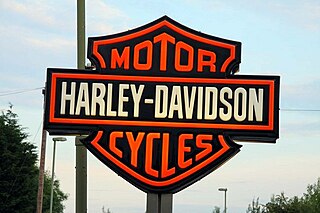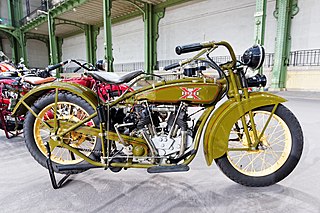Henderson Motorcycle Co.
The founders: William and Tom Henderson
In 1911 the American Henderson Motorcycle Co, 268 Jefferson Ave., Detroit, Michigan, was formed by William G. Henderson in partnership with his brother Tom W. Henderson. Will had the ideas and enthusiasm for motorcycling, and Tom had the better financial acumen. The brothers were inducted to the Motorcycle Hall of Fame in 1998. [2] [3]
1911 prototype
The Henderson brothers constructed a single prototype motorcycle during 1911. The prototype had the belt drive typical of the times, but this was changed to chain drive for production models.
1912 Henderson Four
Henderson Motorcycle promptly announced a new 57 cubic inch (934 cc) IOE four-cylinder 7 hp motorcycle, with the engine mounted inline with the frame and chain drive. Production began in 1911, using the in-line four-cylinder engine and long wheelbase that would become Henderson trademarks, and it was available to the public in January 1912. Advertisements boasted 7 HP and a price of $325.
It was the third four-cylinder production motorcycle built in the United States, and featured a folding hand-crank starter handle.
1913 Model B
Improvements included a better brake (singular), lower seating position, improved girder forks and a rectangular fuel tank, which replaced the previous cylindrical tank. [4] It was in this year that Carl Stearns Clancy of New York returned from circling the globe on a 1912 Henderson, armed with many photographs to prove it. [5]
Heath-Henderson B-4
The Heath-Henderson B-4 engine was a modified Henderson motorcycle engine produced for use in Heath Parasol aircraft. [6]
1914 Model C

The 1914 Model C had a two-speed gearbox incorporated in the rear hub, as well as lighter pistons and adjustable seat springs. [4] (The first Henderson to have gears.)
1915 Model D and E

Shortly after the Model D was announced, it was followed by a Model E, with the wheelbase reduced from 65 to 58 inches, a raised instep on the footboards and a two-speed rear hub. [4] Prices ranged from $295 for the standard model and $335 for the two-speed model. [4]
1916 Model F

The shorter wheelbase became the standard, [4] and the engine now incorporated a cam gear driven "mechanical oiler", and a kick-start. Prices were dropped initially, but due to the impact of World War I on supplies of material and the costs of production, they were increased by $30, with the standard model costing $295 and the two-speed $325. [4]
1917 Model G

The old splash lubrication was superseded by wet sump lubrication. A three-speed gearbox was now attached to the engine [4] and incorporated a heavy-duty clutch. Sales soared and new dealerships were established.
Alan Bedell averaged 48 mph for 1154 miles at Ascot Park in California setting a new 24‑hour record, and then, on June 13, 1917, broke the transcontinental long-distance record of 1915 (set by "Cannonball" Baker on an Indian Twin,) when he rode his 1917 Henderson from Los Angeles to the city of New York (3,296 miles) in seven days, sixteen hours, and fifteen minutes. [7] The roads outside of towns were primitive by today's standards, and the ride would have been more like an off-road ride than the highway tour of today. The Cannonball Baker Sea-to-Shining-Sea Memorial Trophy Dash was named in Baker's honor. Roy Artley also broke Baker's Canada to Mexico record by nearly nine hours, making the journey in just over seventy-two hours. [4]
Despite record breaking and racing successes, the effects of World War I on sales had damaged their financial position.



















